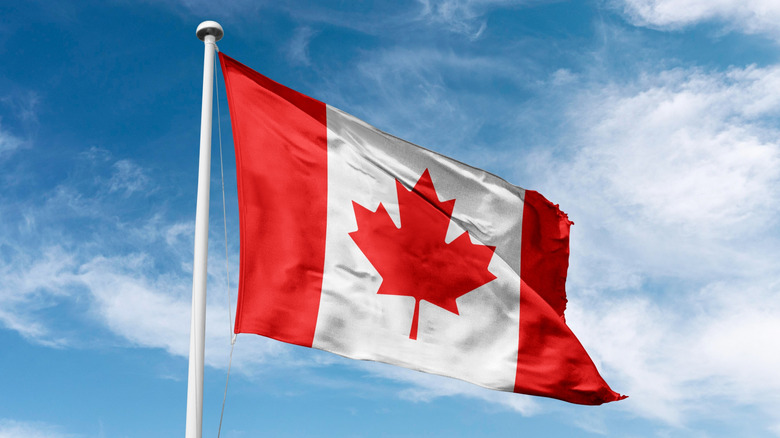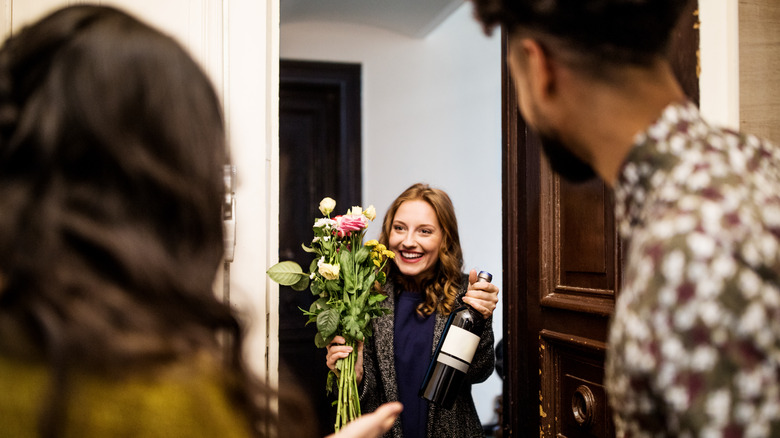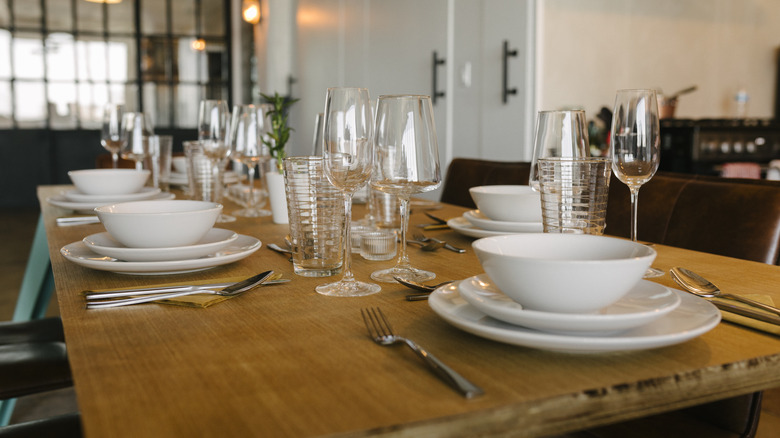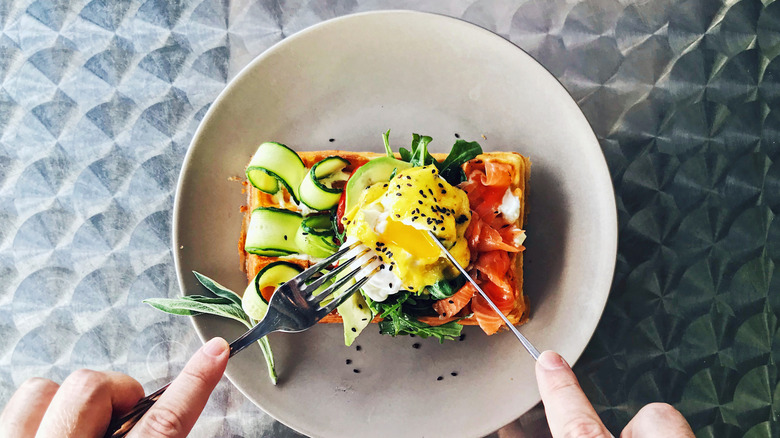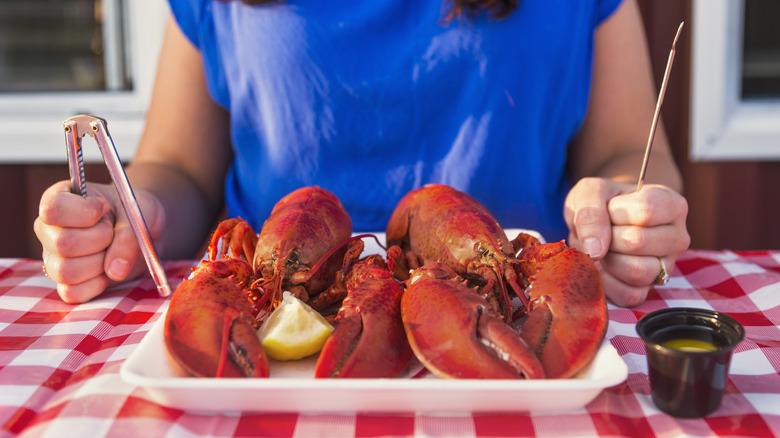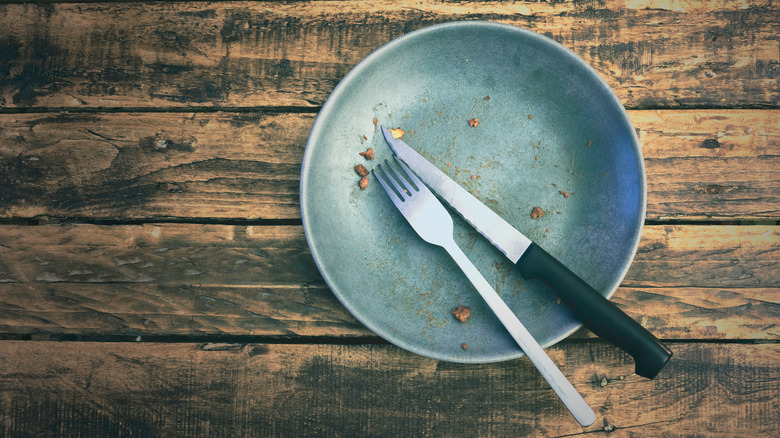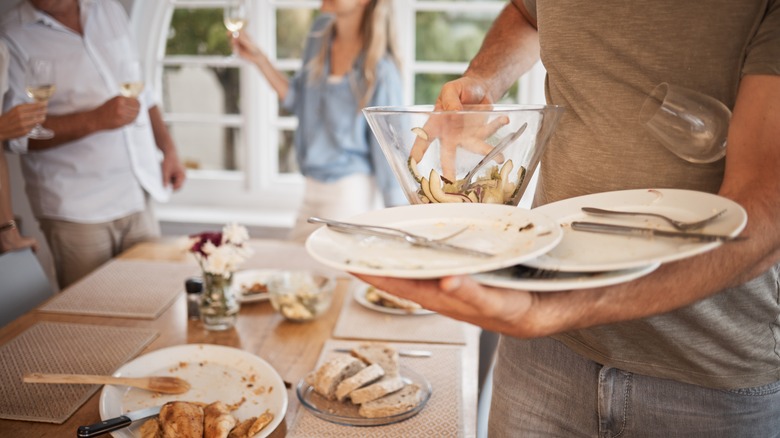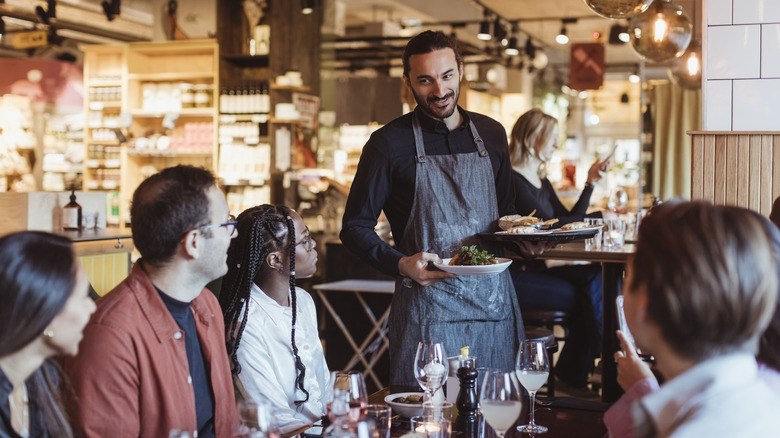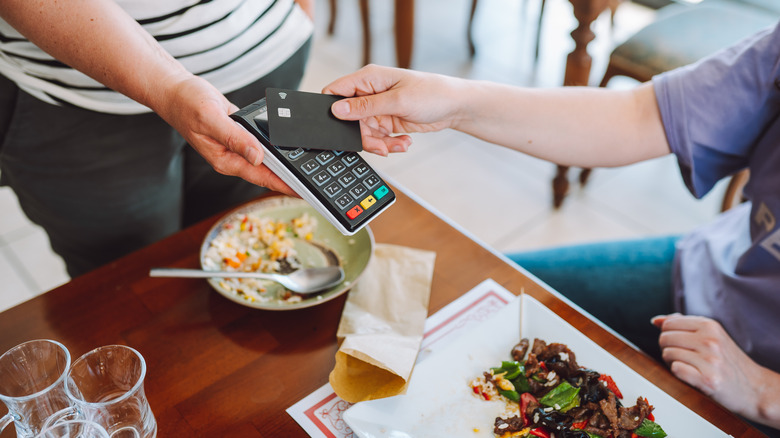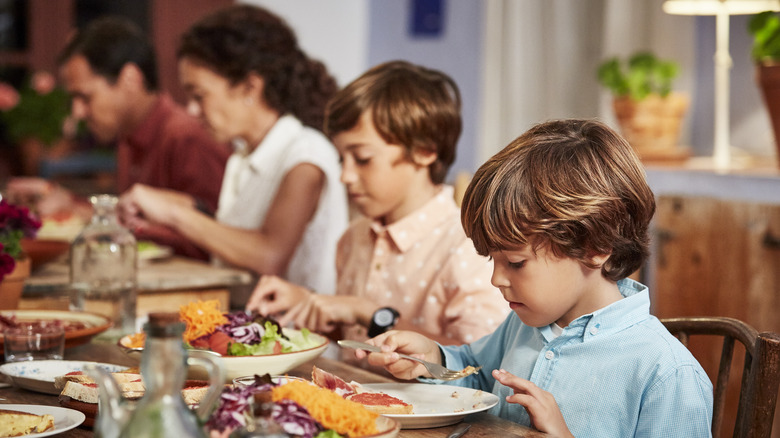The Unique Dining Etiquette Of Canada, Revealed
Seasoned world-travelers and aspiring cosmopolitans often express one similar detail when they regale friends and loved ones with tales of their adventures. And it applies even to close neighbors like Canada. Whether considering culture shock from visiting a remote part of the world far from the reaches of WiFi — or indoor plumbing — or delighting in how much other nations have in common, one universal reality is eating. However, this doesn't mean we all go about it the same way. Understanding the subtle differences between what is or isn't acceptable when dining in Canada could mean all the difference in bridging strong bonds that will have you relishing adding another stamp to your passport.
Just as expectations vary when traveling state to state, journeying to the Great White North brings with it unique standards to adhere to, especially when accepting an invite to dinner in the country where a reputation for politeness reigns. Being on one's best behavior isn't a guarantee to skate by without unintentionally causing offense — in Canada that means following certain rules of etiquette from the moment you arrive to beyond the evening's farewells. From holding your fork to holding your gaze, and knowing when to speak up or not, these unique dining etiquette guidelines will set you straight in all 10 provinces.
Fashionably late? More like fashion faux pas
You may have heard the phrase, "If you're early you're on time, and if you're on time you're late." No matter the variation, it absolutely applies when a Canadian host invites you over for a get-together. There's more to the rules around punctuality than simply showing up when you said you would, and they apply to how you arrive and, heaven forbid, what happens if the clock runs out before you're welcomed inside.
For starters, don't offer excuses — provide explanations. Before you start dreaming up details of a moose blocking the road, remember that honesty is the best policy and own up to that cruller-craving while you snagged a double-double at Tim Hortons on the drive over. More importantly, be prepared to apologize no matter the actual delay and call ahead so that the host can make any necessary adjustments to accommodate a last-minute timing change. To best demonstrate your sincerity, remember to always dress appropriately for the occasion. Polished shoes and wrinkle-free clothes show that you put effort into showing up and that you aren't taking the host's hospitality for granted.
Don't show up empty handed
So long as you factor it into your travel time, stopping at Tim Hortons might be to your benefit as a quick way to pick up something sweet for your host. Of course, that is only one way you might show appreciation as you fulfill the custom of bringing a gift. In this case, your presence doesn't count as their gift. If the aim is to add something to the meal, a good rule of thumb is to call ahead and ask what is being served that you might offer something that suits the theme.
Even if the host isn't interested in serving alcohol at the gathering, pair non-alcoholic cocktail varieties with a focus on the flavors of bitter, salty, sour, sweet, and umami. Worth noting before any feelings get hurt, the host is under no obligation to serve a bottle brought by a guest at their dinner party. They may be more inclined to save it for another occasion. For those less inclined to bring along a drink, dessert, or side dish, flowers also serve well as a show of appreciation for the invite as do any number of tokens of appreciation.
Do just stand there
The warm welcome to a Canadian dinner party might include an invitation to make yourself feel at home, but that doesn't mean there aren't limits. Specifically, locating your place at the table isn't supposed to devolve into a game of musical chairs. While a quaint gathering at a friend's home might not take the level of planning that goes into throwing a formal banquet, the host still may have plotted a preferred seating chart. As such, guests are expected to wait until they are shown to their seats rather than inviting themselves to "take a load off" at their leisure.
Just like showing up for the event on time, there are other cues to stay alert for to make sure you're keeping with etiquette expectations. While the proper home for your napkin throughout the meal is resting in your lap, when it lands there is dependent on when the host finds their own seat. Whether wrapped about utensils or placed on the plate in some fancy design craft with the skill of an expert, the expectation is that it will stay there until the host places their own napkin in their lap to signal that the meal has begun. A similar cue is expected for the end of the meal.
Now, what to do with those hands?
If you consider a dining experience as a journey unto itself, then by this point you've not only made it to the airport on time and cleared security, you've boarded your flight and are awaiting take off. As any seasoned traveler knows, taxiing to the runway includes a quick run-through of basics for both safety and to keep the trip going smoothly. At the dinner table in Canada, what you do with your hands is a lot like that and one of the simplest rules of thumb in is to keep your elbows off the table.
Going beyond that fundamental, many Canadian meals come in more than one course — meaning your setting will have utensils in multiples. As you work your way in from the outermost utensil, Continental style is traditionally adopted with the fork held in the left hand and the knife in the right. Before you get that far, your host may offer the first toast of the evening in which case you are expected to hold your glass at arm's length and hold it high with your fellow diners.
Keep things eye-to-eye
Before shifting attention away from a toast, how you hold your glass isn't the only aspect of your participation to keep in mind when maintaining etiquette. Setting your eyes on the speaker indicates your attentiveness. The same holds true throughout the evening as eye contact is considered key in displaying your respect for whomever is speaking. Another way to keep things eye-to-eye involves the subjects you bring up when interacting.
Topics involving politics, religion, or sex are to be avoided in polite company so as not to spoil the mood or anyone's time. If you're unsure about a subject, err on the side of caution and avoid it. Instead, consider posing followup questions to learn more about a subject someone else already introduced or, if meeting fellow guests for the first time, take advantage of the opportunity to grow more acquainted. As for smartphone use, keeping things social doesn't mean posting everything to your story. While your host might be fine with your enthusiasm for the lovely place settings and stylish centerpieces, it is expected that you ask permission before taking any photos to circulate on the internet.
Dig in with care
If the table is set, guests are seated, food is served, and a toast has been given, you've made it to the main show. Whether or not the host has decided to sit themselves, if the okay to start eating has been given then you're cleared to go — and not a moment sooner. As for how you go about that, think small. When cutting your food, the more manageable the pieces are the less likely you will find yourself in an awkward position trying to finish a bite before responding in conversation or adding your own two cents.
That might not be the only adjustment required for those used to a hands-on approach to eating as even enjoying a piece of bread at dinner should be done with care in Canada. Though you might be inclined to split a roll in half to butter it and enjoy it like a sandwich or slather a slice of toast with jam before treating it like a piece of pizza, know that diners are encouraged to take things slow. While you don't necessarily have to tear up your bread, buttering one bite at a time is the preferred way to maintain decorum.
Tackle tougher foods like soup, pasta, and lobster
Smaller bites cover the basics, but not all dishes are so straightforward — especially if a spoon is involved. Should you be served soup, the main thing to avoid is slurping. If the soup is so hot that gently blowing on it doesn't take the temperature down, consider holding your next mouthful low over the bowl for a few moments. A spoon may also come in handy when presented a noodle dish. Though not a demand of Canadian etiquette, using a spoon to twirl a few strands of pasta around your fork at a time is a step up from using the side of the dish.
Similarly, greater control is what's called for when faced with lobster. Your place setting should include both a lobster fork and a nutcracker in this situation and you'll want to use both to start with the claws. Once you've carefully twisted them off where the knuckles meet the body, employ the cracker on the shells before removing the meat with the fork that typically has two tines. That same fork can be used to remove the meat from the tail and the body after you've separated the two. If you do opt to gather what you can from the body, don't be surprised by the green stuff you find within. Known as the tomalley, the flavorful part of a lobster's digestion is edible, but with a risk of illness or worse if the meal was sourced from waters with harmful algae.
Signs of the end
Though you aren't expected to stuff yourself, failing to clear your plate for the wrong reason can be considered disrespectful to your host in Canada. Barring a dietary restriction, guests should at least make a good effort to finish each course. This is especially true if dinner is served family style and you're responsible for dishing out your own portions. Whether you are lacking in appetite or the flavors just don't work for you, avoid leaving too much behind by starting out with less. Your host will likely be pleased to see you go back for more if the first helping doesn't hit the spot. Alternatively, to avoid breaking etiquette at someone else's house you may consider flattering the host by asking for the recipe when you simply can't handle another bite — but just know that not everyone wants to share recipes, especially if it's a traditional family recipe.
As for how to show that you've had enough, your knife and fork can handle that for you. Once you've had your fill, the polite way to show that you are done eating is to lay the knife on your plate and then cross the fork over it with tines facing down. To show there are no more courses, the host can place their own napkin to the left of their plate.
Show your gratitude
Thanks isn't just something you say, but also something you give. While it is appropriate for a guest to bring a gift of some kind when accepting an invite in Canada, there are still more ways to demonstrate appreciation including one way that both shows your gratitude and relieves the host of some of the work of entertaining. That most straightforward path of thanks involves offering to help clean up after the meal. Be it clearing the table, putting leftovers away, washing the dishes, or taking out the trash, a helping hand means one less thing for the host to accomplish and more time for enjoying company.
Canadian etiquette also dictates that gratitude doesn't end at the door when guests say goodbye. Giving thanks carries over to the next day and doesn't take much. A simple text message, email, or phone call could suffice. But, if you really want to make an impression with your gratitude, sending a card will cement your appreciation for the hospitality.
Take it to the streets
Exercising etiquette while dining doesn't only apply to being a guest in someone's home. In addition to demonstrating respect and thankfulness wherever you go, partaking in a meal at a restaurant uses the same guidelines as those at a residence — only with the addition of treating the waitstaff well. When eating out, especially in Quebec where society is considered more formal than the rest of the country, there is an appropriate way to make requests of a server.
Home to the vast majority of the Great White North's French Canadians — also known as Canadiens — the official language of Quebec is French. So, when vying for the attention of a waiter or waitress, you may say monsieur or mademoiselle respectively. Alternatively, you might beckon the waitstaff by politely stating S'il vous plaît, which translates to if it pleases you, and, as you would with anyone you are speaking with, remember to maintain eye contact.
This rounds on you
In addition to rules for dining, drinking brought with it other rules for etiquette to remember when out and about in Canada. Along with showing proper respect during a toast, there is one key expectation to keep in mind if you're invited out to drinks. It's your responsibility to cover at least one round of drinks.
Whether you've popped into a pub to enjoy a few pints while watching the NHL or you've bellied up to the bar awaiting your table at a restaurant, drinking buddies are expected to take turns settling the tab. This applies to popular apéritifs like champagne, kir, and Pernod — which traced its history alongside drinking absinthe — as well as digestifs like cognac or some other brandy or liqueur. As for during a meal, wine is typically the adult beverage of choice. Should you neglect to pay when it's your turn, you may not leave a good impression on your Canadian friends.
Tipping culture
Though many customs in Canada are akin to the cultures of their European forebears, there is one specific form of etiquette that more closely aligns with their American cousins. Those accustomed to reaching into their wallets for a little extra will feel right at home throughout the provinces. The same can't be said for those who cringe every time a cashier swivels a checkout screen in their direction to answer a prompt about gratuities.
As with America, there is no hard-and-fast rule on how much extra cash you might lay down as a means to thank a server, bartender, or even a barista, and opinions vary. However, any amount between 10-20% is considered acceptable. According to the site etiquette scholar, the most common amount offered in Toronto is an 18% tip, whereas those who want to express displeasure with the service don't leave an employee empty-handed, but instead give an amount less than 15%.
Tomorrow's future, today
Canadians have a fairly simple solution to give their kids an edge at being polite members of society. While some might find it gauche to bring children along to social functions — where they would get relegated to the kiddie table to keep them out of sight and out of mind — that is not the case in Canada.
Giving the youth an edge in etiquette, Canadian kids are permitted to speak to adults, be they parents, teachers, or someone they've just met, in the same manner that they speak to their friends. Instead of being treated like a mere child, being treated as an individual instills politeness and independence for youngsters as they learn firsthand the other rules of decorum. That said, Canadians heap on additional respect when interacting with senior citizens and individuals with disabilities.

